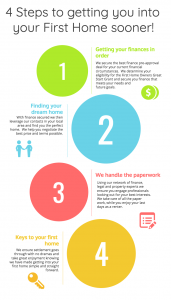Saving a deposit for your first home
The hardest part about saving is saving for something that may not have an immediate pay off like a deposit for a house. Extreme budgeting doesn’t work for many people. You need to ‘live’ in the meantime. So ensuring your budget is realistic is the best way to achieve a longer term savings goal. Put together a savings plan that will meet your savings goals but will allow you and your family to maintain an acceptable lifestyle. There will be some tough decisions about what constitutes a want or need. Finding the middle ground and starting to save today will serve you better than saving a lot for a month or two and then losing motivation and giving up because you were compromising too much on your everyday wants.
First, work out your monthly income and expenses. List all your debts first in order from the highest interest to the lowest interest paid. Then list all your ‘need’ bills which is any thing that keeps you housed, warm and fed such as rent, electricity and groceries. Next up is all your insurances followed by your regular expenses such as transport costs, lunches, coffee, childcare, phone bills and so forth.
Add it all together and work out if you are spending less or more than you earn. If your budget says you should have money left at the end of every month it’s time to go looking for it.
Spend one week recording everything you spend, you may be surprised by what you spend money on that you haven’t already listed above. You may even be shocked by the amount of money going towards unnecessary consumer goods and last minute purchases. This is your missing money. Add these purchases to your budget.
By taking the time to list everything you spend money on and evaluating each items worth against what it is worth to you to buy your own home you will be able to create a list of wants that contribute to your everyday happiness and those that do not mean more to you than buying your own home. Identify these items and make a list that you look at daily to remind yourself that you do not want to spend your money on them anymore. With the items you have decided to ‘keep’ now take a look at where you can cut back, you may cut back on buying coffee mid-week but still treat yourself to a weekend latte and the same could apply to alcohol. Or you might tackle one big change every month. You could even create some temporary budget rules such as you won’t spend anything on sale for 1-6 months in order to stop the habit of buying items you don’t really need. The key is to make a clear plan that suits you and your needs and lifestyle and to keep your goals visible to ensure you stay on track.
Follow your new plan for one month and then evaluate all your expenses again, you may find that something that you thought was important isn’t so much anymore once you see the balance of your savings account going up. Nothing will motivate you more to make changes to your spending than seeing the results of the actions you have already taken. Your budget is ever evolving and you may be surprised at what you are willing to give up once you have been savings for 6 months. The feeling of seeing your short term budget paying off will inspire you to keep going and work harder at your savings goals. This feeling can’t be achieved over night and that is why a realistic budget that you can stick too for more than 6 months will serve you better than a rigid budget that makes day to day life hard and thus any consistent savings over time impossible to maintain.




